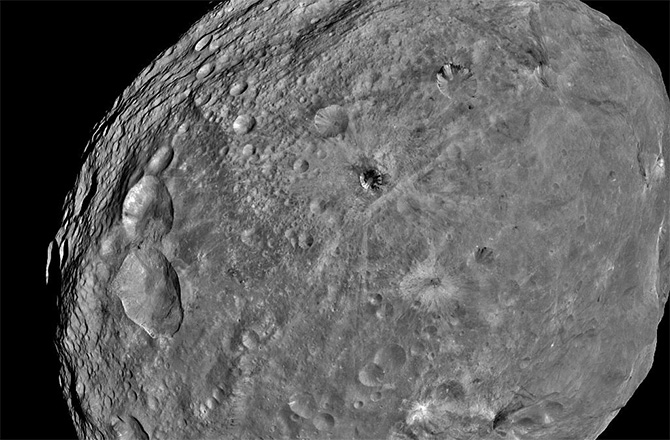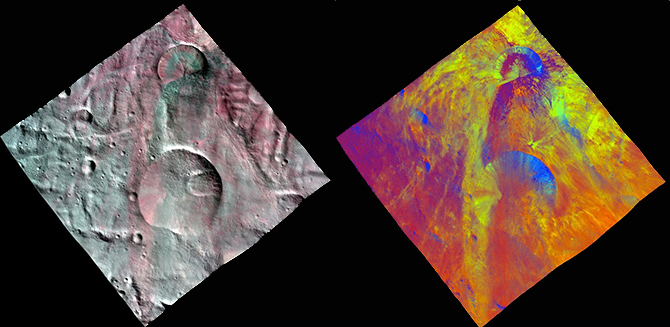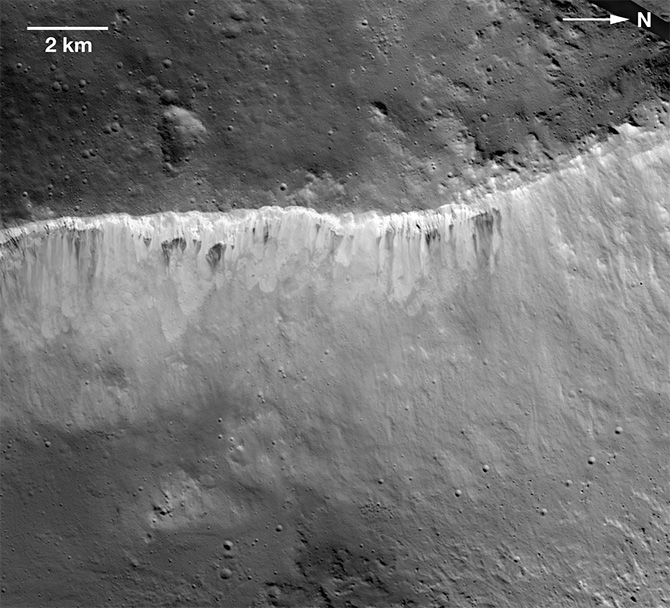Ancient Impacts Mysteriously Erased From Asteroid Vesta

A little less than four billion years ago, as the theory goes, the inner solar system was pummeled by space rocks. It caused craters on the moon and likely left a few marks on the skin of our own planet, which erased over time due to erosion. Called the Late Heavy Bombardment (LHB), a leading theory for why it happened was the outer planets (such as Jupiter and Saturn) adjusting their orbits.
NEWS: Water May Have Once Gushed From Massive Asteroid
Vesta — an airless, large asteroid that orbits in the belt between Mars and Jupiter — doesn't have much evidence of the LHB. We know this from 2011-12 pictures from the Dawn spacecraft, which visited it up close. But why? A new simulation suggests that despite its airless surface, there have been enough rocks pummeling the surface in the last four billion years to erase most of the evidence.
"We computed an increased number of impacts during the LHB that leads to an erosion of the crust of few meters. Since the crust of Vesta is about 20 to 30 km (12.5 to 18.6 miles) deep, this is … compatible with the survival of the crust," wrote lead researcher Simona Pirani, a Ph.D. student at Lund Observatory in Sweden.
PHOTOS: Psychedelic Landscapes of Asteroid Vesta
"We investigated also if we could find any traces of these LHB craters on the surface of the asteroid and we found out that craters produced after the LHB, that is in last 4 Gyr (billion years), efficiently erased the crater population of the LHB event."
This could have implications for how the LHB affected the solar system, Pirani pointed out. Our best models from it come from looking at our nearby moon, but the LHB may have acted differently inside the main asteroid belt, where Vesta resides.
Breaking space news, the latest updates on rocket launches, skywatching events and more!
PHOTO: Asteroid Vesta Up Close
Vesta is one of only a handful of small solar system bodies to be looked at up close. Ceres, where Dawn is orbiting right now, is a dwarf planet with a completely different surface. The ice suspected to lie there, for example, likely causes evidence of craters to erase quite quickly, Pirani said. As for how the erasing took place on Vesta, there are at least a couple of mechanisms that could have caused it, Pirani wrote.
"A possible resurfacing process that could have contributed to erase LHB craters is the wide spread ejecta blanketing, for example. The bigger a target body is, the more ejecta are expected to be retained on its surface after an impact that could affect older craters in the neighborhood," Pirani said.
"Another process to take into account is the seismic shaking following an impact. Vesta showed two big impact basins on the south pole, so the seismic shacking could have been an important mechanism of resurfacing."
BIG PIC: Protoplanet Vesta's Coat of Many Colors
Vesta is a unique asteroid in the main belt because it is the only one where we know we have samples on Earth that came from meteorites. Called HEDs (or Howardite-Eucrite and Diogenite), this gives another window by which researchers can look at Vesta's past.
Simulations of the early solar system's formation indicate there could be a lack of mass in the inner solar system, particularly seen in the case of Mars (a small planet). Pirani said a natural next step in research will be to look at how the mass disappeared, which possibly could have happened when planetary embryos interacted.
A paper based on the research, which has been accepted in the journal Icarus, is now available in preprint version on Arxiv.
This article was provided by Discovery News.

Elizabeth Howell (she/her), Ph.D., was a staff writer in the spaceflight channel between 2022 and 2024 specializing in Canadian space news. She was contributing writer for Space.com for 10 years from 2012 to 2024. Elizabeth's reporting includes multiple exclusives with the White House, leading world coverage about a lost-and-found space tomato on the International Space Station, witnessing five human spaceflight launches on two continents, flying parabolic, working inside a spacesuit, and participating in a simulated Mars mission. Her latest book, "Why Am I Taller?" (ECW Press, 2022) is co-written with astronaut Dave Williams.


